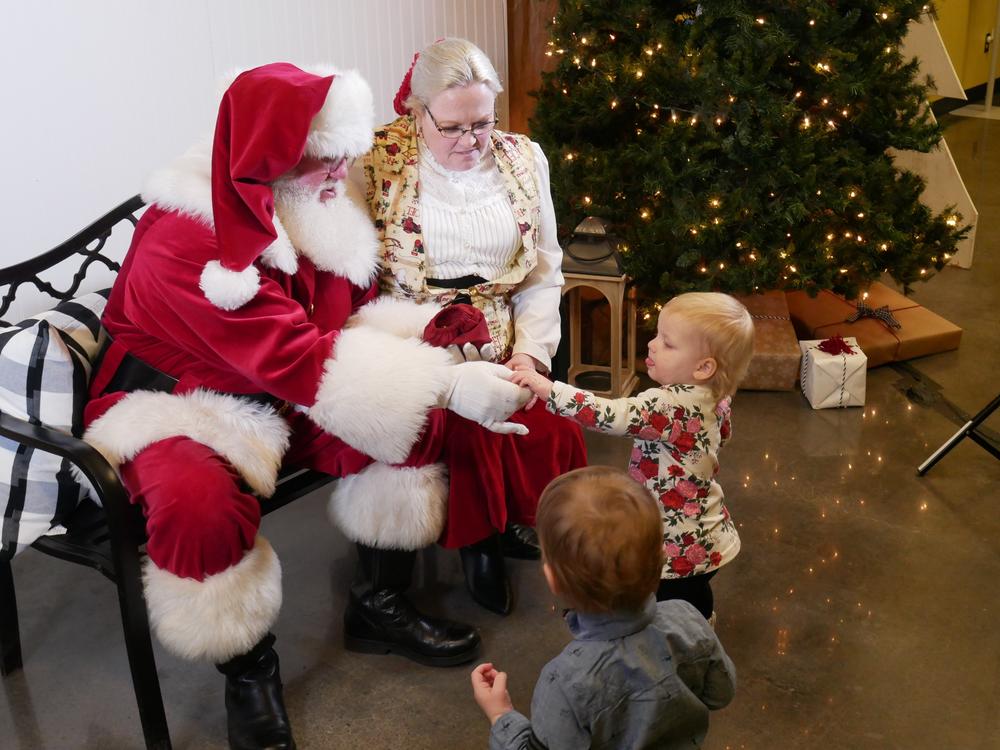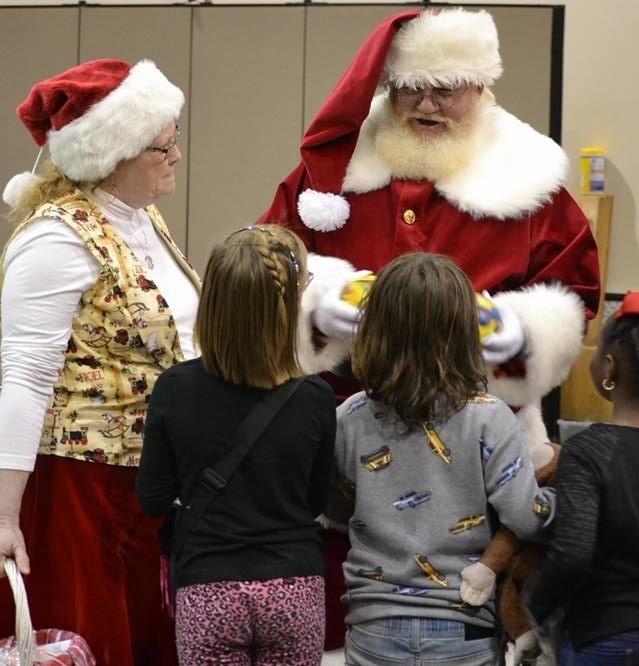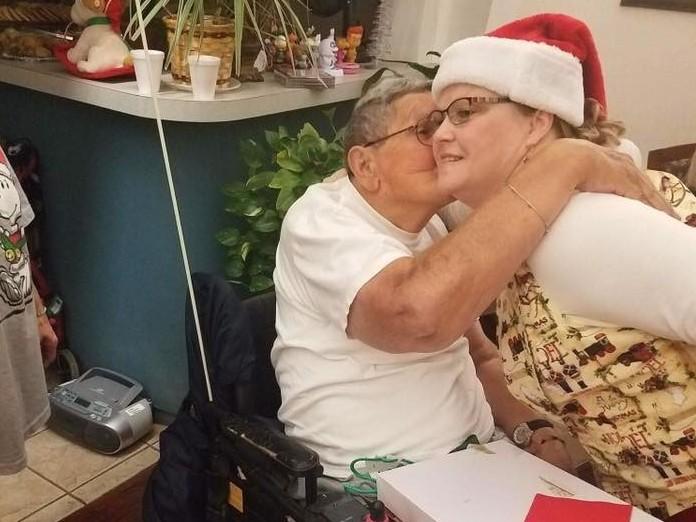Section Branding
Header Content
How COVID-19 Is Making The Holiday Season Not So Jolly For Santa Clauses
Primary Content
The decisions for the people who work as Santa and Mrs. Claus this year are difficult. This high-risk group is trying to navigate keeping the Christmas spirit alive while staying safe amid the pandemic. It's not easy.
For many families, the tradition of the Christmas photo with Santa is an important tradition that is missing this year, but in my family that sense of loss is pervasive because we celebrate the holiday season year-round.
My parents, Keith and Melanie Hubbard, portray Santa and Mrs. Claus. This year, they are experiencing the emotions many of us are. They are tired, sad and a little disoriented because the Christmas season isn't normal.
Over the past decade, the whole Kris Kringle thing has become part of their identity. They use peppermint-scented soap, have stockings hung on the windowsill and wear red year-round.
Because my dad, 62, looks like Santa, it's difficult to go anywhere with him without kids running up to him at the grocery store or while he's pumping gas, which makes it difficult to maintain social distance.
"What do you say to a child that runs up and hugs you? 'Oh no, get away?' No, you hug them back." That's what my mom, 60, said in a recent conversation about how they're dealing with the dilemma.
There have been a lot of difficult conversations with my parents this year. My two siblings and I want to protect them. We know they are at increased risk for COVID-19 because the prerequisites for the Santa job are to be grandfatherly and overweight.
Stephen Arnold is president and CEO of the International Brotherhood of Real Bearded Santas (IBRBS). He says at least three of the organization's 2,200 members have already died from the coronavirus. (One in Florida and two in Texas.)
"That has created consternation amongst ourselves. Whether we cancel the season altogether, whether we ignore the warnings or whether we find a compromise," Arnold said.
Many people who work as Santa depend on what they make as the income they use to pay for basic necessities including rent and food. According to Arnold, there is no typical or average rate for Santa salaries.
"Huge range," he said. "We have many Santas that either take no money but rather perform all charitable work or they accept donations for a favorite charity. Then we have Santas in key markets that do advertising, both print and video, that make well over $100, 000 [per year]. Hourly rates vary widely by market too, with small rural areas supporting low rates of $35-$50/hour and larger markets where $250-$400/hour are not uncommon."
Arnold said there may be variations in the type of work, length of appearance, personal Vs. business, and date and time.
"Typically, the last three days before Christmas and the three weekends before are at elevated rates and then there is Christmas Eve where rates are 2X to 4X higher and substantial tips are not uncommon," Arnold said.
'We are all in a high-risk category'
According to an informal survey IBRBS did of its membership, about one quarter has decided to proceed with Christmas appearances without masks or social distance. Another quarter has canceled their seasons altogether, and the rest have landed somewhere in the middle.
While Dr. Anthony Fauci said earlier this year that the real Santa isn't susceptible to COVID-19, the people who portray him are.
"I don't have to tell you that we are all in a high risk category and I'm sure I don't have to tell you that you need to take precautions so that you don't become ill. This is not something to play around with," Arnold told members in a recent newsletter.
He, however, said this disruption created by the COVID-19 pandemic has led to a lot of innovation including virtual visits, giant plastic snow globes and other events like a recent drive-through event my parents did where they handed donuts to kids by using giant sticks. All of this is designed to keep the people who play Santa and Mrs. Claus socially distanced and safe.
My dad is not a mall Santa. He and my mom live in Cordell, a small town about 100 miles west of Oklahoma City. Working in rural Oklahoma, my parents spend their time visiting with people at community events, in nursing homes and at schools. Most years on Christmas Eve, dad is visiting people in their homes. People just expect to see him around town.
"They've always seen Santa, and he's always been around when they need him, and he can just come by their house," my dad said. "It's just not the same this year."
'That's not what Santa is'
He and my mom tried to establish ground rules to stay safe from COVID-19. We even talked about it as a family. They said children would not be allowed to sit on their laps, they wouldn't hug people or shake hands. With these rules, they agreed to do a few events. When they arrived, however, they found the rules were nearly impossible to enforce.
"When you're taking pictures, people want to put their arms around you and that kind of stuff. It's been very difficult because you have to be standoffish, and that's not what Santa is," he said.
All of it is disappointing. My mom said they feel depressed that they can't be out in the community.
They also feel like they're letting people down. Kids often bring my dad a letter or cup their hand to his ear and whisper things they wouldn't tell anyone else.
"You'll have one child, and they'll be waiting there patiently and quietly and when they get on your lap and you say, 'What do you want this year?' Some of them will say, 'I sure would like something to eat.' It just breaks your heart," my dad said.
Because these kids will tell Santa about their deepest needs, my parents say they are part of an informal trauma response network. In a normal year, they would be able to talk to the teacher or minister nearby to get the child the help they need.
The social distancing required to prevent the spread of COVID-19 means this part of the response network is broken, but my dad and many other people who work as Santa are still trying to meet kids where they are.
In a recent digital event, children were able to ask Santa questions. While there were questions about what kind of cookies Santa likes (sugar cookies with lots of sprinkles) and whether Rudolph always leads the sleigh (yes, his nose lights the way), kids also expressed anxiety about what was happening.
My dad told them this: "I know some of you are having to do school at home, and your parents might not be working right now. I just want to let you know that Christmas is going to be OK. Everyone is going to make it; we're going to make it through this."
While it may be a new normal, my parents are hopeful for next year. They are already booking in-person events for the 2021 holiday season.
Copyright 2020 KOSU. To see more, visit KOSU.



